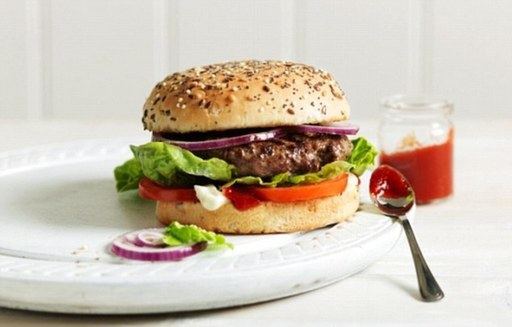全球最贵汉堡:25万英镑用人造牛肉(双语)
The 250,000 hamburger: First test tube-grown beef will be served in London restaurant this week
荷兰马斯特里赫特大学教授马克 波斯特研发出了世界上最贵的汉堡,该汉堡造价高达25万英镑(约合人民币236万元),汉堡中使用的牛肉并非来自牧场的牛群,而是从牛的干细胞中培育出来的。研发人员想借此证明,全球日益增长的蛋白质需求将无需依赖饲养牛群便能得到满足。该研究得到荷兰政府和一位匿名商人的资助,这名商人可能成为试管汉堡的首位品尝者。
科学家表示,这种试管培育的肉有望在十年内上市销售,并且有可能被素食主义者列为可食用材料。牛津大学的科学家在2011年就指出,人造牛肉耗费的能源比自然生长的牛肉少45%;另外,人造牛肉需要的土地空间比饲养牛群少99%,释放的温室气体也比后者少78%到95%。
据联合国粮农组织统计,到2050年全球消费的肉类总量将是现在的两倍,如果不寻求替代品,肉类将会变成奢侈食材。然而在试管肉品正式进入市场之前,英国食品标准局需要证明其食用安全性,并保证它与普通肉的营养价值相同。
 全球最贵汉堡:花费25万英镑用人造牛肉
全球最贵汉堡:花费25万英镑用人造牛肉The world’s first test-tube burger will be served in London next week. It is made from meat grown in a laboratory, rather than cattle raised in pastures.
The world’s first test-tube burger will be served in London next week. It is made from meat grown in a laboratory, rather than cattle raised in pastures.
And its developers hope it will show how the soaring global demand for protein can be met without the need for vast herds of cattle.
The 5oz ‘Frankenburger’, which cost 250,000 to produce, is made from 3,000 tiny strips of meat grown from the stem cells of a cow.
The raw meat is said to be grey with a slippery texture similar to squid or scallop.
It has been created by Professor Mark Post, from the University of Maastricht in Holland.
His research has been funded by an anonymous businessman – who may be the first to try the burger.
He told The Independent on Sunday: 'Right now, we are using 70 percent of all our agricultural capacity to grow meat through livestock. You are going to need alternatives. If we don’t do anything meat will become a luxury food and will become very expensive.’
A four-step technique is used to turn stem cells from animal flesh into a burger.
First, the stem cells are stripped from the cow’s muscle.
Next, they are incubated in a nutrient broth until they multiply many times over, creating a sticky tissue with the consistency of an undercooked egg.
This ‘wasted muscle’ is then bulked up through the laboratory equivalent of exercise - it is anchored to Velcro and stretched.
Finally, 3,000 strips of the lab-grown meat are minced, and, along with 200 pieces of lab-grown animal fat, formed into a burger.
The process is still lengthy, as well as expensive, but it could take just six weeks from stem cell to supermarket shelf.
His work is funded by the Dutch government, as well as an anonymous donation of 300,000 Euros - but it remains to be seen, however, whether the pioneering development will find favor with a public that likes to think of its chops, steaks and sausages as having their roots in nature, rather than in test-tubes.
Scientists say that it is possible the meat will be sold to the public within ten years.
Every kilo of meat requires 10 kilos of plant feed and oil, but cultured meat would only need two.
According to the Food and Agricultural Organisation we will be eating twice as much meat as we do now by 2050.
It is thought that the new form of meat could be acceptable to vegetarians, and animal rights organizations have already given their approval.
Oxford university scientists said in 2011 that cultured beef would need 45 percent less energy than natural beef.
They added that it would require 99 percent less land than regular livestock and produce between 78 and 95 percent less greenhouse gas.
But, the difficulty may be persuading the public to eat an artificial product.
Professor Post said that it is possible to add fatty tissue and nutrients to it, changing the taste and making it more palatable for the public.
But before it became commercially viable, the Food Standards Agency have said that they would have to provide evidence showing it is safe for the public to consume and nutritionally equivalent to regular meat.
(Source:Mail Online)
- 双语:科学家发现鸽子脑内自带空间图2013-07-31 11:10
- 双语:如何培养孩子对数字的敏感度2013-07-30 16:27
- 双语:奥巴马将在白宫与希拉里共进午餐2013-07-30 16:23
- 双语调查:四分之三的五岁幼童每天都上网2013-07-30 16:08
- 双语:地铁被骚扰女性多倾向于保持沉默2013-07-30 16:08
- 双语:教你出轨后如何请求另一半的原谅2013-07-30 15:53
- 双语:5个方法让你工作轻松快乐2013-07-30 15:46
